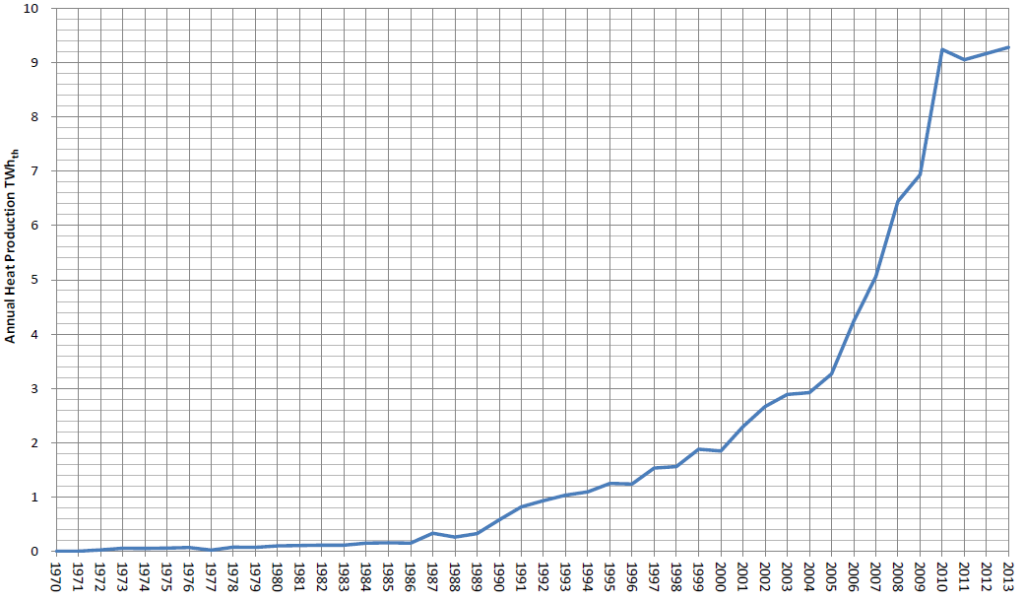Victoria Johnson and Frank Geels
In 1979, an Austrian sawmill owner installed the country’s first biomass district heating (BMDH) plant, delivering heat and hot water from a central boiler via a network of pipes to neighbouring properties. Twenty years later there were 500 schemes, and by the end of 2014 this had risen to 3,100. The country went from importing Swedish biomass boilers in the 1980s, to being a global leader in their manufacture. Now, BMDH provides 22% of space heating and hot water in Austria. How this happened is both impressive and fascinating, providing the opportunity to examine how low-carbon systems like district heating diffuse.
Reductions in energy demand are expected to contribute to more than half of the reductions in global CO2 emissions over the next few decades. As such, the diffusion of low-carbon systems like BMDH – which are more efficient than individual heating systems – will need to occur at a scale and rate that is historically unprecedented. Understanding how and why diffusion of an innovation occurs can, in theory, support the development of the right mix of public policies to support deployment.
Figure 1: Annual heat production from Austrian biomass district heating, in TWh (Statistik Austria, 2015)
Why some technological innovations spread more quickly than others, or more rapidly in one country than another, has been studied for over half a century. Yet the diffusion of technological systems, as opposed to discrete products, has received relatively little attention.
Theoretical models dominating the innovation literature are not sufficient to explain the diffusion of low-carbon systems. These adoption models understand diffusion as the result of purchase decisions by consumers. But consumers are generally not intrinsically motivated by ‘low-carbon’ characteristics and most low-carbon technologies are more expensive and/or offer lower performance. Their diffusion therefore requires public policies (e.g. subsidies, taxes, infrastructure investments) and supportive discourses to create a sense of urgency or positive motivations.
Different adoption models emphasise different factors that shape adoption decisions, such as the flow of information, characteristics of the adopter (e.g. age, income level), attitudes towards the innovation, or economies of scale. Despite these differences, adoption models assume that diffusion of an innovation results from a rational calculation or is informed by adopters’ attitudes and beliefs. They also tend to assume that the adopter is the only actor in the diffusion process and that the environment in which diffusion takes place is fairly static.
While adoption models may explain the diffusion of discrete products, they face problems explaining the diffusion of systems. Systems differ from discrete products in terms of scale, complexity and capital intensity, as well as in spatial, social and political dimensions. System diffusion also involves a range of actors, such as policymakers, supply-side actors (e.g. installers, manufacturers) and civil society, in addition to adopters. Furthermore, because diffusion of technological systems takes years or decades rather than months or years, the environment the system diffuses into is neither static nor homogeneous but varies across space and time.
Given these limitations insights from three further approaches are necessary to understand system diffusion: upscaling (system building), replication and circulation, and societal embedding.
- Upscaling (system building) models suggest diffusion of systems involves, first, piecemeal development, then integration. New systems start as small-scale local schemes and subsequently diffuse when they are combined into large-scale national systems. Electricity or railway systems are good examples.
- Replication and circulation models suggest diffusion happens by systems in one location being replicated in another location. So, diffusion happens through circulation of people, ideas and knowledge between different locations.
- Societal embedding models suggest that new systems need to find their place in the wider society. Thus diffusion occurs through the alignment of system components with broader political, cultural and business contexts.
Low carbon system diffusion is best viewed as a multidimensional process viewed from the perspectives of models of adoption, upscaling, replication and circulation and societal embedding.
Key Findings from the Austrian Context
By examining the diffusion of BMDH in Austria over three decades we find:
- System-builders were crucial for diffusion of BMDH-systems: Motivated by perceived economic opportunities, system builders – actors who actively integrate technological and organisational components (e.g. business models) of a system – played a central role throughout the diffusion of BMDH. Early system-builders were private sawmill owners who built small BMDH schemes fuelled by wood residues for neighbouring properties. From the mid-1980s, forest-owning farmers became important system-builders. With support from regional Chambers of Agricultural and regional governments, farmers formed agricultural cooperatives to develop and operate BMDH, in order to create new markets for wood products. By the early 2000s, energy utilities and service companies became important system-builders, taking advantage of green electricity policies to create a boom in biomass-CHP.
- Replication and circulation is an important model for explaining spatial patterns of diffusion: During the early phases of BMDH diffusion, information circulated by word-of-mouth between neighbouring villages. From the mid-1980s, however, a range of dedicated intermediary actors played an important role in the diffusion process. These actors included regional energy agencies, regional government, Chamber of Agriculture sponsored developers and operators, and the Austrian Biomass Association. They stimulated the circulation of information and knowledge, organised workshops that compared local experiences and funded ‘technological introduction managers’ who worked with developers such as agricultural cooperatives to plan and install BMDH schemes. These intermediaries played a key role in creating rules and standards and in lobbying of policy-makers for funding and support.
- Elements of societal embedding were crucial: Policy support was important to reduce investments risks (via capital grants and feed-in tariffs), stimulate adoption (via subsidies and price regulation) and stimulate knowledge development and circulation. Policy support existed from the early 1980s and continues to the present day. Initial support came from agricultural policymakers, who saw BMDH as a way of assisting farmers and countering rural decline. Energy and climate policy considerations gradually gained importance in the 1990s and 2000s. Additionally, positive narratives created legitimacy for state support. While early narratives focused on rural revitalization, BMDH was subsequently framed in terms of climate change and, since the mid-2000s, in terms of green growth, energy independence, and the national biomass strategy.
- Adoption models are less important for the explanation of early phase diffusion: Economic considerations were less crucial during the early phases of diffusion. Instead, early adopters of village BMDH-schemes had social motivations (helping local farmers and regional economic prosperity) and environmental motivations.
Diffusion of low-carbon systems involves multiple interacting factors and actors, which span techno-economic, political, social and cultural dimensions. A general insight is that single policies are unlikely to result in the successful diffusion of a low energy system.
Table 1: Different policy styles (Geels et al., 2015)
| Market model (bottom up) | Classic steering (top down) | Interactive network governance | |
| Characterisation of relationships | Autonomous (government creates incentives and ‘rules of the game’, but lets actors choose freely). | Hierarchical, command-and-control (government sets goals or tells actors what to do). | Mutually dependent interactions |
| Characterisation of coordination processes | Incentives and price signals | Government coordinates through regulations, goals and targets | Coordination happens through social interaction and exchange of information and resources. |
| Policy instruments | Financial incentives (subsidies, taxes) | Formal rules, regulations and laws | Demonstration projects and experiments, knowledge transfers policies, network management, vision building through scenario workshops, strategic conferences, and public debates. |
Key Lessons for Low Carbon Policy
Based on our research we conclude with five key lessons for policy.
- The importance of multi-level governance: Austria is a federal state, with a form of multi-level governance that enables two-way interactions between provincial and national policies and actors and a more balanced distribution of power and resources between the two. This supported experimentation and policies tailored to provincial social, economic and cultural contexts while national policies set encompassing regulations and offered substantial financial support.
- ‘Market-led’ policies alone are not sufficient: Adoption models often underpin a ‘market’ policy style (Table 1), as in the UK, where the focus is on individual adopters (e.g. pricing, subsidies, taxes or information campaigns). These kinds of policies only played a significant role in the later stages of the Austrian case, however, once supply- chains, networks of actors and a knowledge base had been developed.
- Enduring policies are crucial for supporting system-builders: In the Austrian example capital grants, RD&D programmes and pilot projects supported early stages, but direct cost subsidies remain to this day, creating stability and certainty for system-builders over decades.
- Network governance stimulates the circulation of knowledge: Network governance policies (Table 1) by provincially sponsored energy agencies and the Austrian Biomass Association were crucial in early phases to stimulate circulation and build knowledge. Workshops and seminars helped develop standards and procedures.
- Instead of a policy ‘magic bullet’ policymakers should use a mix of policy instruments that co-evolve with the diffusing system: Austrian policymakers used a mix of instruments and policy styles (Table 1). The policy mix supporting BMDH co-evolved with the diffusion process. During the early diffusion phase, an interactive network governance policy style prevailed at the provincial level, supporting learning, circulation and societal embedding. Later stages of diffusion also saw the introduction of market and classic-steering policy styles while network governance continued to play an important role. The flexible multi-level governance structure in Austria and adoption of all three-policy styles, therefore, supported the long-term diffusion of BMDH. In contrast, in the UK, where market-led policies dominate energy policy, district heating schemes have failed develop a market share of more than 2%
Further Reading
Geels, F.W. and Johnson, V (submitted) “Understanding system diffusion: Adoption models and socio-technical models applied to biomass district heating systems in Austria (1979-2013)”
Geels, F.W., McMeekin, A., Mylan, J., Southerton, D. (2015) “A critical appraisal of Sustainable Consumption and Production research: The reformist, revolutionary and reconfiguration positions” Global Environmental Change 34, 1–12.
Victoria Johnson is Research Associate at the Sustainable Consumption Institute, University of Manchester and the Centre on Innovation and Energy Demand. Frank Geels is Professor of System Innovation and Sustainability at the Manchester Institute of Innovation Research (MIoIR) and the Sustainable Consumption Institute (SCI) both at the University of Manchester. Frank is also Co-director of the

